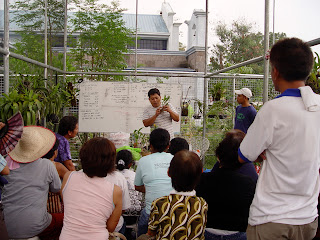Chapter 2: An orchid conservation project...
I visited the site and progress of a new orchid conservation project in the Philippines called 'The Orchid and Plant Species Conservation and Livelihood Program'. It is a project aimed at both conserving Philippine species and providing people living in orchid habitats with a source of income. Species will be sourced through donation or rescue programs and people in the community will be given the skills and opportunity to cultivate, propagate and eventually sell these species. In addition, propagated plant will also be considered for species re-introduction. Overall, the project hopes to conserve orchid and plant species through reducing the dependence on wild-collection for the ornamental trade, and the efforts of plant rescue, propgation, and re-introduction.

A local orchid specialist lecturing on orchid culture and conservation inside the orchid house that has been built in one of the communities

This is me entering the orchid house, excited about seeing the progress that the community has made with orchid species cultivation.
For more information, visit the Philippine Orchid Society at: http://www.philorchidsociety.org/ and read the article I wrote for their newsletter and website.

3 Comments:
Hey Jenn,
Thanks for the research updates and all the great pix! I read your article on the POS site - had no idea that tree fern was endangered! What exactly is Madre de Cacao? Besides being something from the cacao tree (?) I haven't heard of it before.
Can't wait to hear more about your research!
Hello, this is my first visit to Orchidelirium. I'm so surprised with the vast amount of orchid-goodness inside this blog. I am very interested as well on the research news and like Naomi above I also didn't know before that the fern was endangered.
I am definitely going to visit frequently to this blog. Keep up the great posts!
Madre de cacao is also known as kakawate in Tagalog, and its latin name is Gliceria sepium. It is native to Mexico but introduced in the Philippines. It is a fast-growing species and is also commonly used for wood for cooking fires. The reason it is called Madre de cacao is that it is also planted to shade cacao trees in plantations. Being a larger tree and fast grower I guess it serves the purpose quite well! I didn't know tree fern was endangered either, before coming to the Philippines. Although supposedly populations are doing well in the Philippines, it is harvested from the wild and not done sustainably. Two full genera are on CITES appendix II - Dicksonia and Cyathea. The thing is, it is difficult to know if the tree fern you are purchasing is from a plantation or not. So many exporters lie and say things have been artificially cultivated when in reality they have been taken from the forest. In countries that don't have the funds to actually check people out thoroughly they just believe them and give out CITES permits easily. And with appendix II species you only need an export, not an import permit.
For orchid horticulture in the Philippines they use pieces of Madre de Cacao as mounting slabs as well as charcoal. But most are still using tree fern.
Post a Comment
<< Home